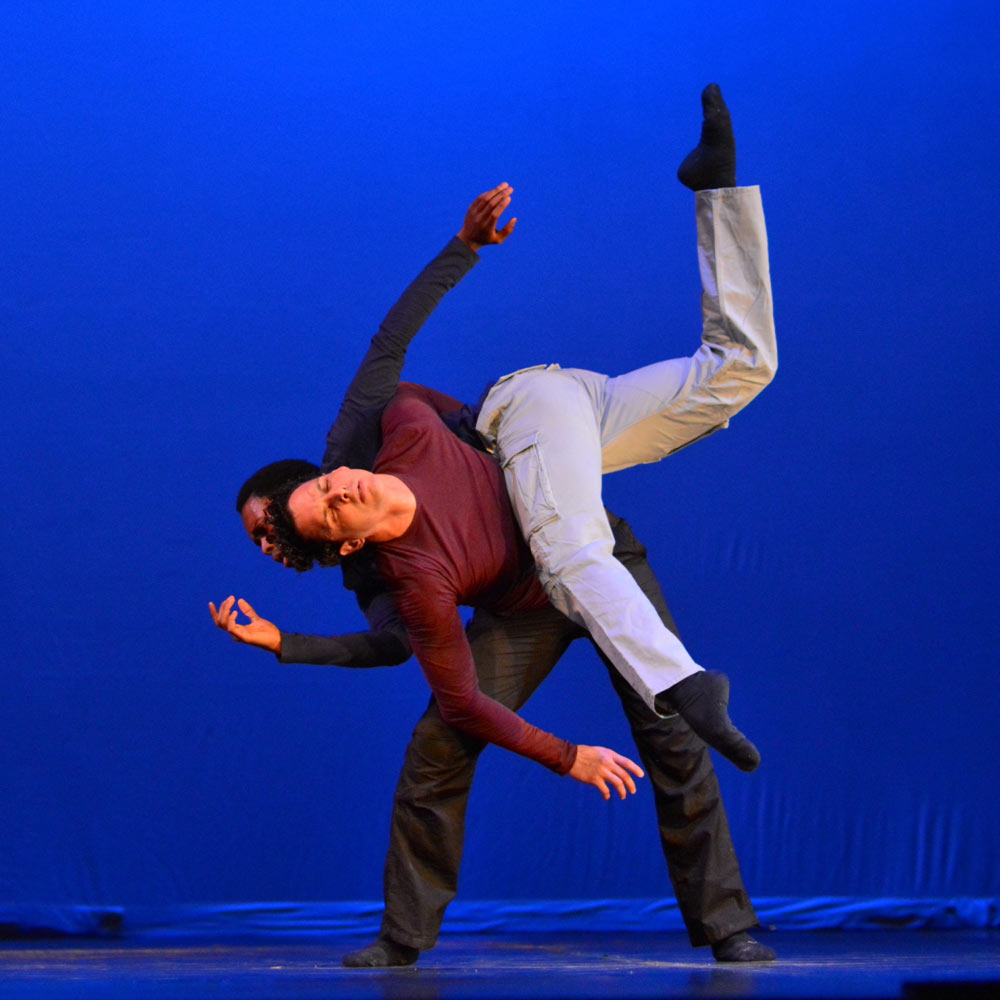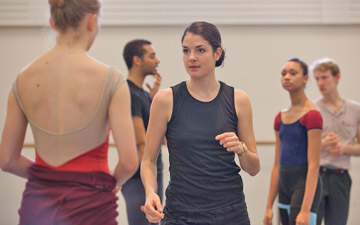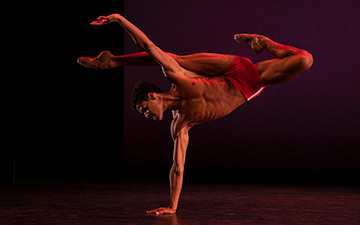
© Paul Wegner. (Click image for larger version)
Chamber Dance Project
SI-8 and SI-9, Exit Wounds…and Then They Come Home, Arranged, Sur, Wild Swans
Joyce Theater Ballet Festival
New York, Joyce Theater
6 August 2015
chamberdance.org
www.joyce.org
Chamber Dance Project is essentially what it says on the tin: a small dance troupe which performs to live chamber music.
Performing as part of the Joyce Theater’s Ballet Festival, the Washington D.C.-based company, led by Artistic Director Diane Coburn Bruning, programmed five works by three choreographers, plus two instrumental, dance-free interludes (a work by Russell Peck and Prokofiev’s Sonata for Two Violins in C Major). It’s a tall order for a troupe of any size, and a bit like a restaurant with an overly diversified menu: more is not necessarily better.
Coburn Bruning is a strong believer in improvisation and collaboration. Her belief in the experimentation is so strong that, before the curtain goes up, she sometimes hands musicians a score they’ve never played together before, and gives the dancers “directions for structured improvisation.” In her own words, the result is “a premiere each performance.”
Following this method for her work SI-8 and SI-9, she added two photographers, who crouched around the stage, dodging dancers and trying to snap dancers between grands battements. As an idea, it is playful, potentially fun. The execution and quality of the end result is, of course, subject to numerous, unpredictable factors. On Thursday night, the clusters of dancers were thick, and the movements hard to see. One photographer looked more like he was filming a video, which made his movement somehow more static and looked less spontaneous.

© Paul Wegner. (Click image for larger version)
Exit Wounds….And Then They Come Home by Coburn Bruning was a more successful venture. Set to a selection of movements from several Philip Glass string quartets, it is an often impassioned pas de deux for two men – not something even the most adventurous companies do very often. Performed Thursday night by Davit Hovhannisyan of Milkwaukee Ballet and Jacob Bush from Atlanta Ballet, Exit Wounds is a romantic tug-of-war, if not tragedy, including some mixture of vague strife, lovemaking and unmaking. Several of the lifts are striking, including one in which Bush lifts Hovhannisyan (both of whom are men with a capital “M”) – his two legs piercing the air like a pair of open scissors. Coburn Bruning plays with weight and gravity, and by default – trust. The melodrama grows as the piece continues, and starts to consume it, taking precious time away from the night’s most interesting work. The piece ends with Bush cradling Hovhannisyan in a curled, fetal-like position: a trope overused by many choreographers for traditional heterosexual pas de deuxs. While it was good to see a different incarnation of this instinctual “hold me” moment, one can’t help but ask when we will also see, with more frequency, a woman cradling a man.
Arranged, also by Coburn Bruning, features three female dancers donning white lace veils. They sit on those white cafe chairs we see at all outdoor weddings, with rose petals at their feet. The music: the haunted strains of Arvo Part. Creating a statuesque silhouette, the veil creates a completely different line for the body, and its imagery comes heavily weighted. The veil has statuesque authority. It is the symbol of the saint and sinner. At once an emblem for the Madonna and the last, symbolic shroud of a virgin on her wedding day, it’s also the shroud of the sinner, and an alternative to a mask – a traditionally devious device. Arranged is, given its title, trying to say something about the institution of marriage (maybe every marriage, despite our delusion of choice in the matter, is ”arranged?”), but it feels more like performance art than contemporary dance. Francesca Dugarte, Morgan Rose and Luz San Miguel strike a few poses and ronds de jambe in slow motion while seated on the chairs, and you have the bulk of the movement.

© Paul Wegner. (Click image for larger version)
Sur, choreographed by Jorge Amarante, is balletified tango, up to a point. Several of the movements are too slow to really feel any sense of rhythm or drama, and the livelier sections are fine, but there is something wanting, and it might be Paul Taylor. Women get dragged around on the floor with some frequency, and one couple exits only to return in American Apparel underwear and perform a sexualized pas de deux. While it might be the “offstage” result of a sexy tango partnering, the work didn’t gain anything from bringing it onstage and unclothed. Wild Swans, by New York-based Darrell Grand Moultrie is a contemporary ballet work filled with convex and concave contrasts, and frequent fidgets (think some works by van Manen or Forsythe). While the work ends with dancers stalking the audience and worming their bodies into grotesques, the majority of the work largely featured fairly traditional contemporary partnering. The dancers were working hard, but had varying degrees of intensity with each other. It’s possible as an ensemble company they didn’t have enough time together to really delve into their partnerships.
The musicality of the dancers was not always as high as one might hope, given the troupe’s dedication to performing to live music; however, it must be noted that these dancers don’t perform together frequently. Pulling talent from various places can spark great things, but maybe a more pared-down program with fewer variables would help these collaborations to fully thrive.

















You must be logged in to post a comment.